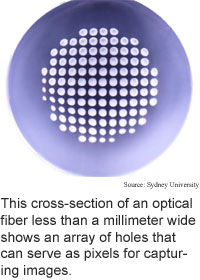
Patterned fiber makes tiny scope
Researchers from the University of Sydney
in Australia have found a way to make an endoscope that's a dozen times
smaller than today's 10-millimeter versions. The technology should make
it possible to image areas that are inaccessible today.
Endoscopes, which are made from bundles of optical fibers, are
commonly used to provide images from inside the body. They are also used
to provide images from other difficult-to-access areas like the insides
of jet engines and nuclear reactors.
The researchers constructed a microscopic pattern of air channels
within a single, four-fifths-of-a-millimeter-thick plastic fiber to provide
an array of pixels capable of carrying an image from one end of the fiber
to the other.
The photonic crystal fiber, which contains a square array of 112
air holes, is a plastic version of more common glass photonic crystal
fiber. The device can provide an image by channeling light either through
the polymer material between air holes or through the air holes.
The multichannel fibers could also be used as optical connectors
between computer processors or from a computer processor to a memory module,
according to the researchers. This would boost data transfer rates by
allowing multiple channels per fiber rather than just one.
To make a practical endoscope the device needs to be fitted with
a lens and engineered to provide illumination and image collection from
the same fiber.
A practical endoscope could be produced within three years, according
to the researchers. The work appeared in the January 26, 2004 issue of
Optics Express.
Red wine mends solar cells
Search tool aids browsing
Tiny pumps drive liquid circuits
X-shape pulses hold together
Briefs:
Patterned fiber makes tiny scope
Atom spouts photons on demand
Channel shapes split microdrops
Chip controls neural connection
Atomic microscope spots viruses
Charges make micro whirlpools

Research Watch blog
View from the High Ground Q&A
How It Works
RSS Feeds:
News
Ad links:
Buy an ad link
Ad links: Clear History
Buy an ad link
|
TRN
Newswire and Headline Feeds for Web sites
|
© Copyright Technology Research News, LLC 2000-2010. All rights reserved.